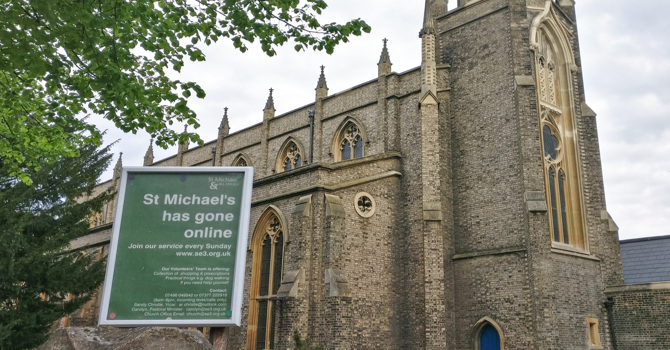People today -- especially young people -- belong to fluid networks that are not limited by traditional religious boundaries, family relationships or geography. That is both reflected and facilitated by the Internet, said Heidi Campbell, an associate professor at Texas A&M University.
This has deep implications for Christian institutional leaders, who may see it as a threat or an opportunity -- or simply the way their members now live.
“They don’t go between the church world and the Internet world. They just live in both spaces,” said Campbell, who refers to this as “networked religion.” “The Internet is not transforming religion. In many respects, what it is [doing] is just reflecting these broader shifts that are also happening offline.”
Campbell researches the intersection of media, religion and culture, with a special interest in the Internet and digital, mobile culture. She has written or edited four books and more than 60 articles and book chapters on religion and new media, including the 2013 edited volume “Digital Religion: Understanding Religious Practice in New Media Worlds.”
Campbell spoke to Faith & Leadership about the five key characteristics of networked religion and how institutions might respond to it. The following is an edited transcript.
Q: How do you see change happening on and offline, and how does each reflect the other?
“Networked religion” is a concept that I put forth in an article called “Understanding the Relationship between Religious Practice Online and Offline in a Networked Society.”
The concept of networked religion is recognizing that religious practices and relationships are being informed by the structures of the networked society.
The social relationships that we live in are now increasingly decentralized. They’re increasingly more fluid. Religion and religious culture are also being influenced and shaped by these larger forces in society that people like [sociologist] Manuel Castells have talked about.
In a networked society, if we live in a place that we have more global interconnections and sense of accountability, and our traditional relationships and patterns of belief are becoming much more individualized and less tied to institutional constraints and boundaries, we get a version of religion that is much more individual.
It’s much more dynamic. This matches a lot of what the Pew Research Center has found regarding trends toward having “belief but not belonging” or “faith without affiliation.”
What we see is a consistency between trends online and trends offline.
One of the fears has been, for the last decade, that people would plug in, log on and drop out of society and church and different social relationships. But what scholars have found is that people online are importing their belief structures and understandings into that new space.
The Internet is not transforming religion. In many respects, what it is [doing] is just reflecting these broader shifts that are also happening offline.
Q: What kind of advice or guidance or ways of thinking about this would you suggest to people who are still committed to existing institutions?
I don’t like to be prescriptive unless I know the religious organization well.
One thing I do with networked religion is that I identify five key characteristics of networked religion, this highly mobile, dynamic, fluid, loosely bound form of religiosity online.
So these are some places that you can have some specific conversations about how these traits may be affecting your community, or to what extent you would see this trait as something you could leverage for the positive -- or see it as problematic.
One example, one characteristic is networked community. [This] suggests that many religious groups such as churches now function as loose social networks rather than tightly bounded social networks, and this means that people see their church community as one part of their social network.
It’s not the hub anymore for many people. So people have varying levels of commitment and affiliation and may be involved in more than one religious community, and they network them together through their daily lifestyle and their practices in using media and other events to connect those things.
For many people, especially young people, the church they go to on a Sunday is just one part of their religious community and network.
Institutions could either see it as a threat and say, “How can we get increased buy-in into our institution? How can we brand ourselves in a way that’s cohesive, to show people how they can carry us and the community and integrate them into a lifestyle, and give resources to connect people to community?”
Or they could just recognize that’s the reality and say, “OK, how can we create resources that give added value and then show people that they can be involved in our community and other spaces but also show how those other passions or other social groups could be connected, even if it’s in a loose way, to our institution?”
People no longer live in these tightly bound groups that are defined by family or institution or geography. They live in these networks that are fluid, and it’s up to the institution to see, how are we going to frame that -- as a challenge or an opportunity? And in what ways can we leverage that?
Q: What are the other characteristics?
Another characteristic is the idea of what I call storied identity. Storied identity shows how people’s religious identity is malleable rather than fixed. It used to be that a religious identity was something you took on through maybe religious education or confirmation or baptism. You kind of put it on like a cloak.
But now people see identity as something that you can negotiate, that you construct and you perform. So individuals especially use the Internet and other resources to seek out their own “spiritual tribe” online -- a group of people where they can make sense of their religious self and their religious belief.
Facebook and Twitter, blogs, social media allow people to express their religious identity, to experiment and to create a cohesive identity that’s free from institutional constraints. Again, religious organizations need to look at what the implications are of that, because our identity is created often by the tribe of people we associate with, and that may or may not be the church or institution that we go to on a regular basis.
Storied identity is how people construct their religious identity, in the sense that they’re trying to create a narrative that makes sense about who they are.
Q: One of the implications for institutions seems to be sort of flexibility or fluidity.
And that’s obviously something that many institutions are not used to. They’re used to having their clear mission statement and set of principles that have been decided by committee and worked out through certain authority structures.
If you’re going to do that vetting process, you’re going to lose a lot of people along the way, because they’re just not used to that in an instantaneous, global culture.
Q: Are the other aspects also related to this fluidity?
[Another characteristic] is what I call convergent practice -- how, especially in the digital culture, people are able to move through spaces very quickly. It encourages people’s blending practices and information from multiple sources.
The fourth characteristic is what I call multi-site reality, and this is where we see that the online and offline worlds are connected by people, because no longer is the Internet something that you log on to and go into this separate space. It’s something we carry with us in our back pockets.
People are trying to live in this bridged, hybrid space all the time and trying to, through their practices and conceptual framework, link them in ways so that they don’t have conflict with themselves. They see it as whole people living in multiple contexts.
Then the last one is the idea of shifting authority.
The initial concerns were that the Internet was going to undermine religious leaders, and there are definitely examples of how there are new religious interpreters emerging online, whether they be “theoblogins” or thought leaders through social media like Twitter.
But we also see that religious leaders in the last five to seven years have become very media-savvy and have seen how they can use the Internet to either re-establish their authority or solidify their networks.
The Internet both challenges and empowers religious institutions simultaneously.
Q: Do you think that there is a gap between online and offline that needs to be bridged in the religious world, or do you see them as a fluid, intermingled space?
That depends again on your ideas and background. The organizations that see the Internet as this other space, they tend to do one of two things. Either A, it becomes the mission field -- they think it’s a space that’s inherently secular, and we have to sanctify it. But the problem with that is sometimes they don’t recognize that there actually is a lot of faith and spirituality and good discourse happening.
Or B, they see it as “another space,” and we have to distance ourselves.
I think the problem is that it is this integrated space, and it’s a space where people live. They don’t go between the church world and the Internet world. They just live in both spaces.
So it’s more a matter of, how do you do spiritual development, religious education, create community in that hybrid space when you recognize that even though your institution may not be living in that space, this is where most of your people, and especially young people, live?
So it is a new territory, but it’s a territory you need to understand rather than just seeing it as something you need to cultivate or sanctify.
I’m researching now what I call “religious digital creatives,” and so I’m interested in looking at how individuals use new media or leverage their new media skills for ministry and what kind of connection that has or relationship it has to institutional churches. Do churches recognize that ministry? Do they see it as a threat or as competition, or do they try to embrace them and bring them into the mission and goals of the institution?
I’ve also been interviewing Web designers, people who are media officers for denominations, and finding out that many of these people are trying to be innovative in their use of social media, but they’re slowed down by either finances or time in their schedules, or just the fact that their institution doesn’t understand, “Why are you spending so much time on the Facebook and Twitter feeds for our denomination rather than doing the annual or monthly newsletter?”
So there’s a sense that the structures don’t allow for some of the innovation that other people can do very easily.
Q: How would you advise institutional leaders in approaching new media?
I believe that we should be techno-realists. This was a movement in the mid-1990s, and basically it was trying to address the early hype about the Internet -- that the Internet was either going to save humanity or it was going to destroy and enslave people.
They had a list of principles like “Computers will not destroy nor will they save our education system.” Technology has both promises and perils.
What does the technology offer you, and what kinds of characteristics does it encourage in positive ways? What are maybe the problematic -- both technical and moral -- traits of the technology?
A techno-realist would say that basically you need to be technologically and new media literate, but you also need to understand your own religious identity and mission very clearly and then be able to line them up once you understand the digital culture and your own culture.
Where do you see places that that technology and that theology can intersect in positive ways, and then how do you find people who are already doing that, as well as develop resources?
A lot of churches, when they do, just get on the new media bandwagon; they have the “if we build it, they will come” mentality: “We’re going to go spend all this money on this website, spend time building these social media platforms.” And then they wonder why they flop.
Because it’s maybe more to their benefit to actually find out if their organization, their community is already doing these things and then support that and encourage those activities that build the values, that build the theology, that build the community that they want.















